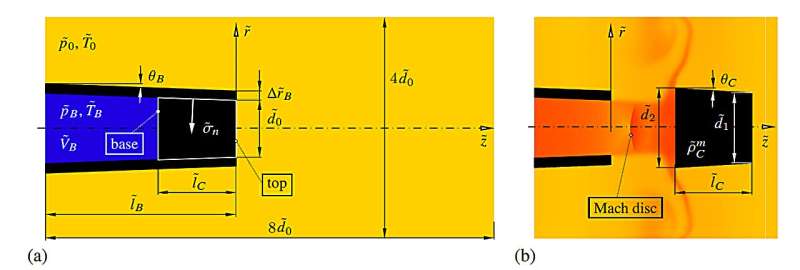(a) Computational domain (initial conditions) of the bottleneck termination gas of the coupled system; (b) Detail of the density map ???? = 0.5 ms. Credit: arXiv (2023). DOI: 10.48550/arxiv.2312.12271
When you open a bottle of champagne, a complex supersonic phenomenon occurs. Scientists at the Technical University of Vienna are now able to calculate exactly what happened for the first time.
It sounds like a simple, well-known, everyday phenomenon: high pressure exists in a champagne bottle, and the cork is pushed outward by the compressed gas in the bottle and flies away with a powerful “pop.” But the physics behind it are complex.
Experiments with high-speed cameras have been performed, but mathematical numerical analysis is lacking. The Technical University of Vienna has now bridged this gap. Using sophisticated computer simulations, the behavior of the plug and airflow can be recalculated.
During the process, an amazing phenomenon was discovered: a supersonic shock wave was formed, and the air flow could reach more than one and a half times the speed of sound.Results appear on a preprint server arXivis also important for other applications involving gas flow around ballistic missiles, ballistics or rockets.
shock wave from bottle
“The champagne cork itself flies away at a relatively low speed, about 20 meters per second,” said Lukas Wagner, first author of the study and a doctoral student at the Institute of Fluid Dynamics and Heat Transfer at TU Vienna. ) explain. Research is also being conducted at the private Austrian Competence Center for Tribology (AC2T).
“However, the gas flows out of the bottle much faster,” Wagner said. “It overtakes the cork, flows through it and reaches speeds of 400 meters per second.”
That’s faster than the speed of sound. As a result, shortly after the bottle is opened, the gas jet breaks the sound barrier, accompanied by a shock wave. Typically, variables such as pressure and temperature in a gas are constantly changing: two points close to each other also have approximately the same air pressure. But when a shock wave occurs, it’s a different story.
“These variables undergo jumps, so-called discontinuities,” says Bernhard Scheichl (TU Vienna and AC2T), Lukas Wagner’s thesis supervisor. “Then the pressure or velocity at the front of the shock wave has completely different values than at the back.”
This sudden change in pressure in a gas jet is also called a “Mach disk.” “A very similar phenomenon exists in supersonic aircraft or rockets, where the exhaust gases exit the engine at high speeds,” explains Stefan Braun (TU Vienna), who came up with the original idea for the project and supervised Wagner Mr. Master’s thesis on this topic. The Mach disk first forms between the bottle and cork and then moves back to the mouth of the bottle.
Temporarily colder than the North Pole
Not only the air pressure, but also the temperature changes suddenly: “As we know from spray cans, when a gas expands, it gets colder,” explains Lukas Wagner. This effect is very noticeable in champagne bottles: the gas can be cooled to -130C at certain points.Carbon dioxide may even form tiny dry ice crystals2 This makes the sparkling wine fizzy.
“This effect depends on the original temperature of the sparkling wine,” says Lukas Wagner. “Different temperatures produce dry ice crystals of different sizes, which then scatter light in different ways. This produces different colors of smoke. In principle, you could measure the temperature of sparkling wine by looking at the color of the smoke.”
Cork expansion and shock wave bursting
“The fact that supersonic phenomena actually occur when a bottle of sparkling wine pops is not clear at first and you don’t necessarily think about it,” says Bernhard Scheckel. “But our simulations show that this arises naturally from the equations of fluid mechanics, and our results are in good agreement with experiments.”
The popping sound you make when you open a bottle is a combination of different effects: first, the cork suddenly expands as soon as it leaves the bottle, creating a pressure wave, and second, you can hear the shock wave jet produced by the supersonic gas, which is very similar to the well-known aeroacoustic phenomenon of sonic boom. resemblance. Together they create the characteristic sound of a champagne cork popping. The expansion of the plug was modeled based on experiments conducted by Mr. Wagner at AC2T.
The methods now developed to solve the physics challenges surrounding the popping of champagne corks can also be applied in other related fields: from firing pistol bullets to firing rockets, in many technically important situations you are dealing with very solids that interact strongly with each other. of fluid. Faster airflow.
More information:
Lukas Wagner et al., Simulating the opening of a champagne bottle, arXiv (2023). DOI: 10.48550/arxiv.2312.12271
Journal information:
arXiv
Provided by Vienna University of Technology
citation: Final clarification: The physics of popping champagne (2023, December 21) Retrieved December 21, 2023, from https://phys.org/news/2023-12-physicals-champagne.html
This document is protected by copyright. No part may be reproduced without written permission except in the interests of fair dealing for private study or research purposes. Content is for reference only.
#Finally #clarified #physics #popping #champagne
Image Source : phys.org
